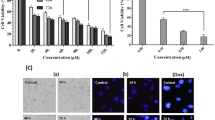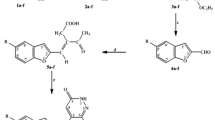Summary
Clinical resistance to adriamycin (ADR) develops readily, and cardiotoxicity is a major dose-limiting side effect. A range of anthracycline derivatives have been synthesized recently, and a number reported to exhibit significantly reduced cardiotoxicity in experimental animals. Using NIL 8 Syrian hamster overy cells and two continuous human tumour cell lines derived from colon carcinomas we have screened a series of 11 anthracycline analogues, determining their in vitro cytotoxic effects by colony-forming assays. Five agents proved significantly more cytotoxic than ADR: dihydroxyanthraquinone (DHAQ), mitoxantrone (DHAD), 4-demethoxydaunorubicin (4-DNR), 4′-0-tetrahydropyranyl-adriamycin (THP-ADR), and 4′-deoxyadriamycin (4-ADR). We have also established in vitro a subline of the L5178Y murine lymphoma resistant to ADR and have used this model to identify derivatives with potential value for overcoming ADR resistance. We have observed three patterns of response: (i) complete cross-resistance with 4′-epiadriamycin and daunorubicin; (ii) slight cross-resistance with 4-DNR, THP-ADR, 7-con-0-methyl-nogarol and aclacinomycin A; and (iii) complete absence of cross-resistance with 4-ADr, 4′-0-methyladriamycin, DHAQ, DHAD, and methylhydroxyellipticinium. These straightforward preclinical screens thus identify three drugs which may merit clinical evaluation, since they not only show an increased level of cytotoxicity in vitro to ADR at equivalent concentrations but also overcome resistance to ADR in this murine model system.
Similar content being viewed by others
References
Anderson KC, Cohen GI, Garnick MB (1982) Phase II trial of mitoxantrone. Cancer Treat Rep 66:1929
Barfod MN (1977) Flow microfluorimetric estimation of G1 and G2 inhibition of the JB-1 tumour cell cycle in vitro. Exp Cell Res 110:225
Bargiotti A, Casazza AM, Cassinelli G, Di Marco A, Penco S, Pralesi G, Supino R, Zaccara A, Zunero F, Arcamone F (1983) Synthesis, biological and biochemical properties of new anthracyclines modified in the aminosugar moity. Cancer Chemother Pharmacol 10:84
Benjamin RS (1975) A practical approach to adriamycin (NSC-123127) toxicology. Cancer Chemother Rep 6:191
Berman E, Wittis RE, Leyland-Jones B, Casper ES, Gralla RJ, Howard J, Williams L, Baratz R, Young CW (1983) Phase I and clinical pharmacology studies of intravenous and oral administration of 4-demethoxydaunorubicin in patients with advanced cancer. Cancer Res 43:6096
Bhuyan BK, Blowers CL, Crampton SL, Shugars KD (1981) Cell kill kinetics of several nogalamycin analogues and adriamycin for Chinese hamster ovary, L1210 leukemia, and B16 melanoma cells in culture. Cancer Res 41:18
Carter SK, Livingston RB (1982) Drugs available to treat cancer: In: Carter SK, Glatstein E, Livingston RB (eds) Principles of cancer treatment. McGraw-Hill, New York, p 95
Casazza AM, Pratesi G, Giuliani F, DiMarco A (1980) Anti-leukemic activity of 4-demothoxy-daunorubicin in mice. Tumori 66:549
Cassinelli G, Ruggievi D, Arcamone F (1979) Synthesis and antitumour activity of 4′-0-methyldaunorubicin, 4′-0-methyladriamycin, and their 4′-epi analogues. J Med Chem 22:121
Clarysse A, Brugarolas A, Siegenthaler P, Abele R, Cavalli F, De Jager R, Renard G, Rozencweig M Hansen HH (1984) Phase II study of 9-hydroxy-2N-methylellipticinium acetate. Eur J Cancer Clin Oncol 20:243
Critchley DR, Chandrabose KA, Grahem JM, Macpherson I (1974) Glycolipids of NIL hamster cells as a function of cell density and cell cycle. In: Clarkson B, Baserga R (eds) Controls of proliferation in animal cells. Cold Spring Harbor Laboratories, Cold Spring Harbor, p 481
DiMarco A, Skovsgaard T, Casazza AM, Pratesi G, Nissen NI, Dano K (1981) Cross resistance and cellular uptake of 4′-0-methyldoxorubicin in experimental tumours with acquired resistance to doxorubicin. Cancer Chemother Pharmacol 7:15
Drewinko B, Shaver A, Yang LY (1978) Nutrient-dependent colony-forming capacity of cultured human colon carcinoma cells. Invest Cell Pathol 1:341
Drewinko B, Yang L-Y, Barlogie B, Trujillo JM (1983) Comparative cytotoxicity of bisantrene, mitoxantrone, ametantrone, dihydroxanthracenedione, dihydroxyanthracenedione diacetate, and doxorubicin on human cells in vitro. Cancer Res 43:2648
Fujimoto S, Ogawa M (1982) Antitumour activity of mitoxantrone against murine experimental tumours: Comparative analysis against various antitumour antibiotics. Cancer Chemother Pharmacol 8:157
Giuliani FC, Kaplan NO (1980) New doxorubicin analogs active against doxorubicin-resistant colon tumour xenografts in the nude mouse. Cancer Res 40:4682
Giuliani FC, Coirin AK, Rice MR, Kaplan NO (1981) Effect of 4′-doxorubicin analogues on heterotransplantation of human tumours in congenitally athymic mice. Cancer Treat Rep 65:1063
Hill BT (1980) Lethal and kinetic effects of DDMP (2,4-diamino-5-(3′,4′-dichlorophenyl)-6-methylpyrimidine). Eur J Cancer 16:147
Hill BT, Whelan RDH (1982) Establishment of vincristine-resistant and vindesine-resistant lines of murine lymphoblasts in vitro and characterisation of their patterns of cross-resistance and drug sensitivity. Cancer Chemother Pharmacol 8:163
Hill BT, Price LA, Goldie JH (1976) The value of adriamycin in overcoming resistance to methotrexate in tissue culture. Eur J Cancer 12:541
Hill BT, Whatley SA, Bellamy AS, Jenkins LY, Whelan RDH (1982) Cytotoxic effects and biological activity of 2-aza-8-germanspiro [4,5]-decane-2-propanamine-8,8-diethyl-N,M-dimethyl dichloride (NCS192965: spirogermanium) in vitro. Cancer Res 42:2852
Hubbard SM, Barkes P, Young R (1978) Adriamycin therapy for advanced ovarian carcinoma recurrent after chemotherapy. Cancer Treat Rep 62:1375
Inoue K, Arakawa M, Miyamoto H, Ogawa M (1983) Activity of 4′-0-tetrahydropyranyladriamycin hydrochloride (THP-ADM) in a human tumour cloning system. Invest New Drugs 1:271
Johnson RK, Chitnis MP, Embrey WM, Gregory EB (1978) In vivo characteristics of resistance and cross-resistance of an adriamycin-resistant subline P388 leukemia. Cancer Treat Rep 62:1534
Johnson RK, Broome MG, Howard WS, Evans SF, Pritchard DF (1983) Experimental therapeutic and biochemical studies of anthracenedione derivatives: In Rozencweig M, Von Hoff DD, Staquet MD (eds) New anticancer drugs: Mitoxantrone and bisantrene. Raven, New York, p 1 (Monograph series of the European Organization for Research on Treatment of Cancer, vol 12)
Karanes C, Young JB, Smason KK, Smith LB, Franco LA, Baker LH (1983) Phase I trial of aclacinomycin-A. Invest New Drugs 1:173
Kimler BF, Cheng CC (1982) The comparison of the effects of dihydroxyanthraquinone and adriamycin of the survival of cultured Chinese hamster cells. Cancer Res 42:3631
Minna JD, Carney DN, Cuttitta F, Gazdar AF (1983) The biology of lung cancer: In: Chabner BA (ed) Rational basis for chemotherapy. Liss, New York, p 1
Minow RA, Benjamin RS, Gottlieb JA (1975) Adriamycin (NSC123127) cardiomyopathy — an overview with determination of risk factors. Cancer Chemother Rep 6:195
Muggia FM, Rozencweig M (1983) The anthracycline antibiotics: New directions in drug development and cancer treatment. In: Muggia FM (ed) Cancer chemotherapy, no 1. Nijhoff, The Hague, p 123
Ogawa M, Miyamoto H, Inigaki J, Horikoshi N, Ezaki K, Inoue K, Ikeda K, Usui N, Nakada H (1983) Phase I clinical trial of a new anthracycline: 4′-0-tetrahydropyranyl adriamycin. Invest New Drugs 1:169
Robustelli Della Cuna G, Pervase K, Preti P, Ganzina F (1983) Clinical evaluation of 4′-epi-doxorubicin in advanced solid tumours. Invest New Drugs 1:349
Rozencweig M, Crespeigne N, Kenis Y (1983) Phase I trial with 4′-deoxydoxorubicin (esorubicin). Invest New Drugs 1:309
Salmon SE, Liu RM, Casazza AM (1981) Evaluation of new anthracycline analogs with the human tumour stem cell assay. Cancer Chemother Pharmacol 6:103
Schwartz HS, Kanter PM (1979) Biochemical parameters of growth inhibition of human leukemia cells by antitumor anthracycline agents. Cancer Treat Rep 63:821
Scott JP, Fraccastora AP, Taft EB (1965) Studies in histochemistry: I. Determination of nucleic acids in microgram amounts of tissue. J Histochem Cytochem 4:1
Semple TV, Quinn LA, Woods LK, Moore GE (1978) Tumour and lymphoid cell lines from a patient with carcinoma of the colon for a cytotoxicity model. Cancer Res 38:3145
Taetle R, Howell SB, Giuliani FC, Koziol J, Koesler A (1982) Comparison of the activity of doxorubicin analogues using colony-forming assays and human xenografts. Cancer 50:145
Tihon C, Issell BF (1982) Activity of anthracyclines on human tumours in vitro: In: Muggia FM, Young CW, Carter SK (eds) Anthracycline antibiotics in cancer therapy. Nijhoff, The Hague, p 247
Traganos F, Staiano-Coico L, Darzynkiewicz Z, Melamed MR (1981) Effects of aclacinomycin on cell survival and cell cycle progression of cultured mammalian cells. Cancer Res 41:2728
Tsuruo T, Iida H, Tsukagoshi S, Sakurai Y (1982) 4′-0-tetrahydropyranyl-adriamycin as a potential new antitumour agent. Cancer Res 42:1462
Von Hoff DD (1982) Screening the second-generation anthracyclines in a human tumour cloning system: In: Muggia FM, Young CW, Carter SK (eds) Anthracyclines antibiotics in cancer therapy. Nijhoff, The Hague, p 240
Von Hoff DD, Coltman CA, Forseth B (1981) Activity of mitoxantrone in a human tumour cloning system. Cancer Res 41:1853
Wasserman TH, Comis RL, Goldsmith M, Handelsman H, Penta JS, Slavik M, Soper WT, Carter SK (1975) Tabular analysis of the clinical chemotherapy of solid tumours. Cancer Chemother Rep 6:399
Zirvi KA, Van der Bosch J, Kaplin NO (1982) In vitro responses of nude mouse-xenografted human carcinomas exposed to doxorubicin derivatives in tissue culture and in the mouse. Cancer Res 42:3793
Author information
Authors and Affiliations
Rights and permissions
About this article
Cite this article
Hill, B.T., Dennis, L.Y., Li, XT. et al. Identification of anthracycline analogues with enhanced cytotoxicity and lack of cross-resistance to adriamycin using a series of mammalian cell lines in vitro. Cancer Chemother. Pharmacol. 14, 194–201 (1985). https://doi.org/10.1007/BF00258115
Received:
Accepted:
Issue Date:
DOI: https://doi.org/10.1007/BF00258115




